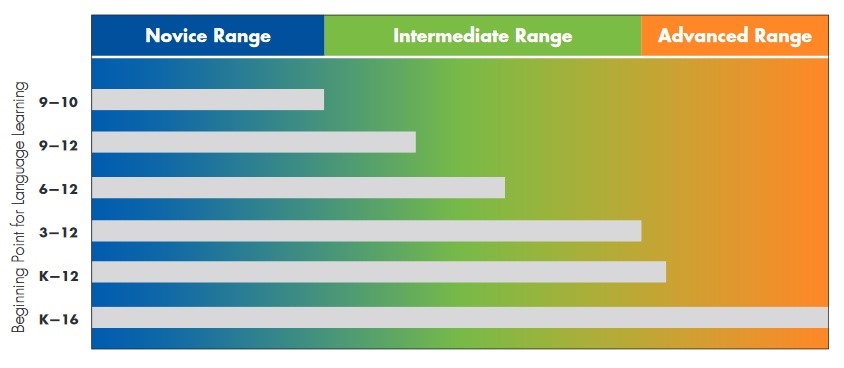Applying World Language Performance Level Expectations
For a more complete version of this information, please read “Applying Performance Level Expectations for World Language Programming”, pages 7-9, of the Nebraska World Language Standards Approved September 2019.
The Ultimate Expectation for Language Knowledge and Skills
Once an ultimate goal has been determined, the school can dedicate the time and resources necessary to meet the goal. The critical factor to consider in this process is the level of language needed to negotiate successfully in life, careers, and academia.
College readiness
Colleges and universities, and even individual departments within colleges and universities, have specific language entrance and graduation requirements. The average expectation is that incoming college freshmen will have had two to four years of high school world language. Since requirements vary so greatly, it is strongly recommended to contact specific programs and institutions for more information.
Life readiness
The ability to function bilingually also strongly affects one’s quality of life. Language function dramatically increases cognitive function well into older age, Bilinguals have greater ability to see and understand nuances, to investigate actively, to use critical thinking, and to seek a more profound level of communication.
Career readiness
The ability to communicate in multiple languages has a proven economic value. Local, regional, national, and international markets are actively seeking employees who can respond to customers and negotiate agreements.
The American Council on the Teaching of Foreign Languages shares a comparison of oral proficiency levels needed in the workplace in order to be career ready. View their graphic “Oral Proficiency Levels in the Workplace” to determine what levels of language are required for different careers.
Programming for the Ultimate Expectation
Once a district has determined an expectation for the ultimate level of language performance, programming needs will be considered. There is a definite correlation between the level of language expectation and the amount of time given to study and practice. In the American Council on the Teaching of Foreign Language graphic, “Time as a Critical Component for Developing Language Performance”, we see that a stronger investment in the duration and depth of a language program will result in higher and more useful levels of language performance. The chart can also be seen on page 13 in the ACTFL Performance Descriptors for Language Learners.
 Source: “Figure 4: Time as a Critical Component for Developing Language Performance”, ACTFL Performance Descriptors for Language Learners, 2012 Edition, Alexandria, VA: ACTFL, p. 6.
Source: “Figure 4: Time as a Critical Component for Developing Language Performance”, ACTFL Performance Descriptors for Language Learners, 2012 Edition, Alexandria, VA: ACTFL, p. 6.





